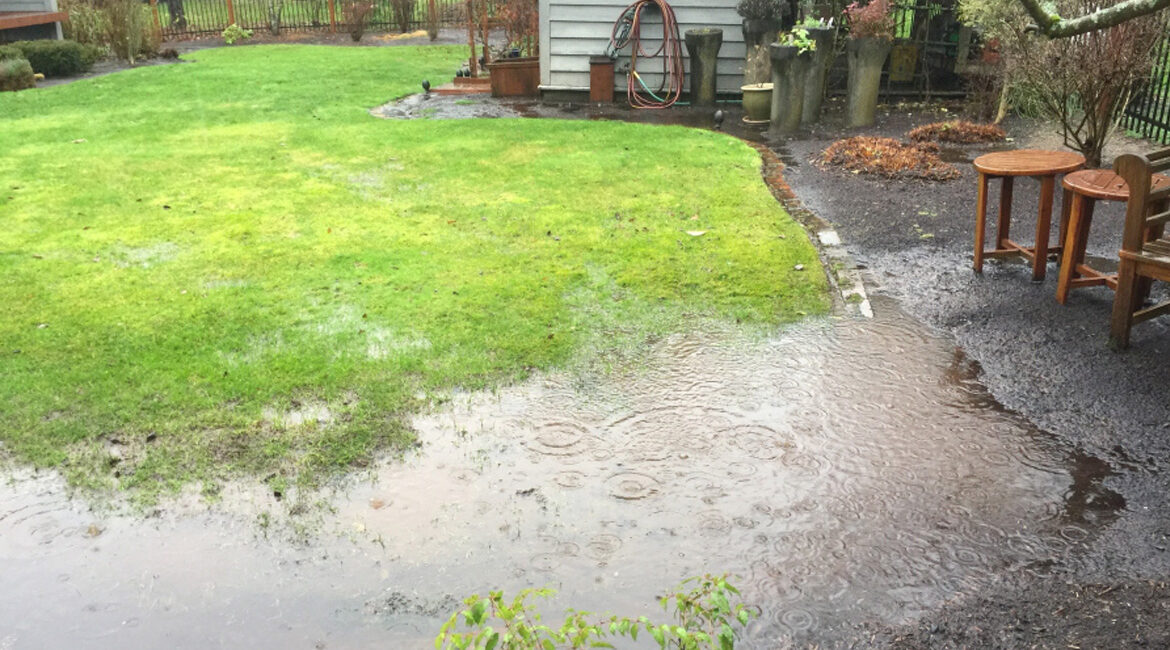2014 ended up being one of the wettest summers many of us have ever experienced. While such a summer may have been good for lake levels, lawns, and gardens (if they didn’t flood), it was very hard on many homes. While we saw some once-in-a-lifetime and unpredictable situations, we saw many more problems that could have been avoided by some easy and often inexpensive corrections had the homeowners been aware of the potential issues beforehand.
Egress wells and downspouts don’t mix. While we’ve seen this before, this past summer was simply disastrous for many people with downspouts in close proximity to egress wells. We repeatedly saw serious damage from egress wells flooded by downspouts such as: broken windows and flooded basements, drainage tile under the basement floor plugged with eroded soil, egress wells pulling off of foundations, and damage from hydraulic pressure to the foundation itself. Many if not all of these problems could have been avoided by reconfiguring the gutters and downspouts so that they weren’t dumping right next to a window well. $3000-5000-or sometimes even upwards of $10,000 worth of damage could have been prevented by spending $300-700 with a competent gutter company and having any improperly-located downspouts moved away from egress wells.
A/C units should NOT be positioned right next to an egress well. Central air units and the precast concrete pads under them can be heavy, and therefore exert considerable downward forces on the soil under them. When these units are placed right next to an egress well, and the soil becomes waterlogged from irrigation or excessive rainfall, bad things happen. Granted, a properly installed egress well can stand this extra pressure, but many if not most wells are not correctly done. This past summer we saw many examples of window wells collapsing or bowing inward from the weight of the adjacent central air unit. Removal and repositioning of the A/C unit, and replacing the egress well normally costs between $2,000 and $4,000. Repositioning the A/C unit before any damage has occurred to the window well costs about $300-500. A little money spent on preventative maintenance can prevent a much more expensive and troublesome repair later on.
Downspout extensions are there for a reason. Mark my words—after EVERY significant rain, we get calls about damp, wet, or even flooded basements that can be traced back to missing/unattached/damaged downspout extensions. Some examples of what we hear: “We took then off to mow the yard”. “The lawnmower guy ran over it and crushed it.” “Was it important?
I threw it away.” And my personal favorite: “I didn’t like the color of it so I took it off.” The downspout extension moves the roof water AWAY from the foundation and out into the lawn where it can usually dissipate harmlessly. Without the downspout extension, every drop of rainwater that hits the portion of the roof drained by that section of guttering and downspout gushes right down against your foundation with predictably bad results. Those little green or white flexible extensions are troublesome as well and should be avoided. They fall off, or the wind that blows in preceding the thunderstorm blows the end of them right back against the house which can cause way more damage than if they weren’t there in the first place. Cost of new downspout extensions—around $10 per downspout. Keep those original-type downspout extensions on!!
Water flows downhill. If the backfill around your foundation has settled, you’ll have a low spot next to your basement wall. Since we can’t defy the laws of physics, this will indeed spell trouble. If the rainwater then hits the siding and runs down the outside wall of your home can’t flow harmlessly out and away from the foundation, it will accumulate and cause damage. The droughty summer of 2013, which caused an unusually large amount of shrinking and settling of soil, followed by the very wet summer of 2104, was a perfect storm for these issues. Homeowners will be dealing with the effects of this indefinitely until it’s corrected. The soil must be brought in and the grade must be corrected. Keep in mind that the landscaping (river rock, pea gravel, mulch, etc.) doesn’t count when checking the grade around your home. These things are just sieves; the grade of the soil underneath is what matters and it must be sloped away from the home.
What can a homeowner do? Almost all homeowners are capable of a basic inspection to see if trouble likely lies ahead. Take a look at those downspouts to make sure they aren’t too close to an egress well and appear to be doing their job. If you’re A/C unit is in close proximity to an egress well, does the well look sturdy and properly attached? Rake back the rock, mulch, etc., in your landscaping and check the grade of the soil next to your foundation. Don’t forget to look under your deck!! Does the soil under the deck slope away from your foundation as it should? Don’t ignore the warning signs you’ve been given that hint of larger troubles ahead. Fix any deficiencies you’re capable of doing, and call in the professionals for the rest. A bit of sweat and relatively inexpensive preventative maintenance now will save you significant headaches and much larger expenses later on.
Copyright Dave Pepper 2015
Dave Pepper owns and operates A Plus Skidloader Services, LLC, with locations in Ames and Clear Lake.

